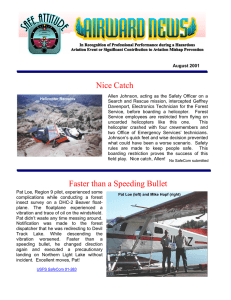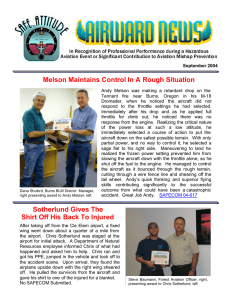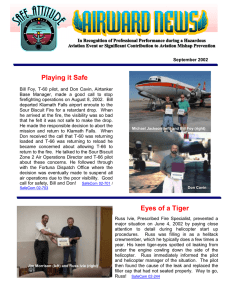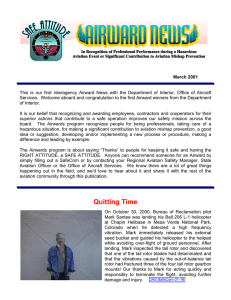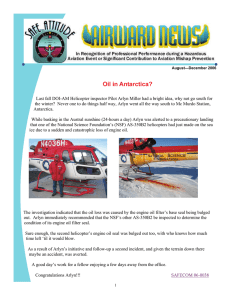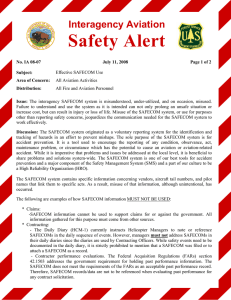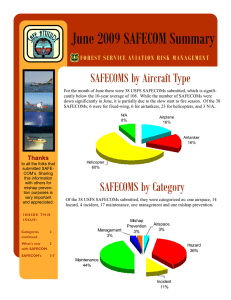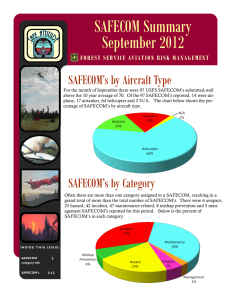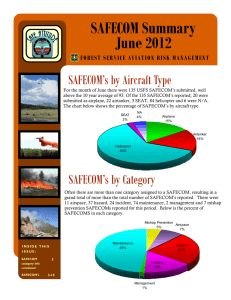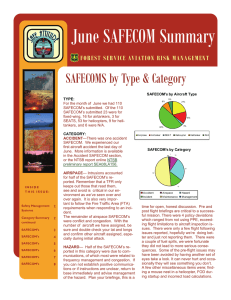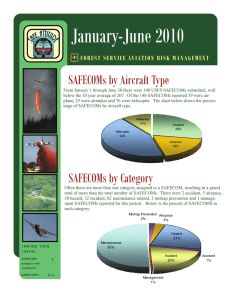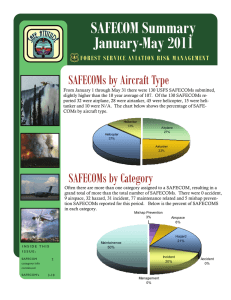Golden Moment
advertisement
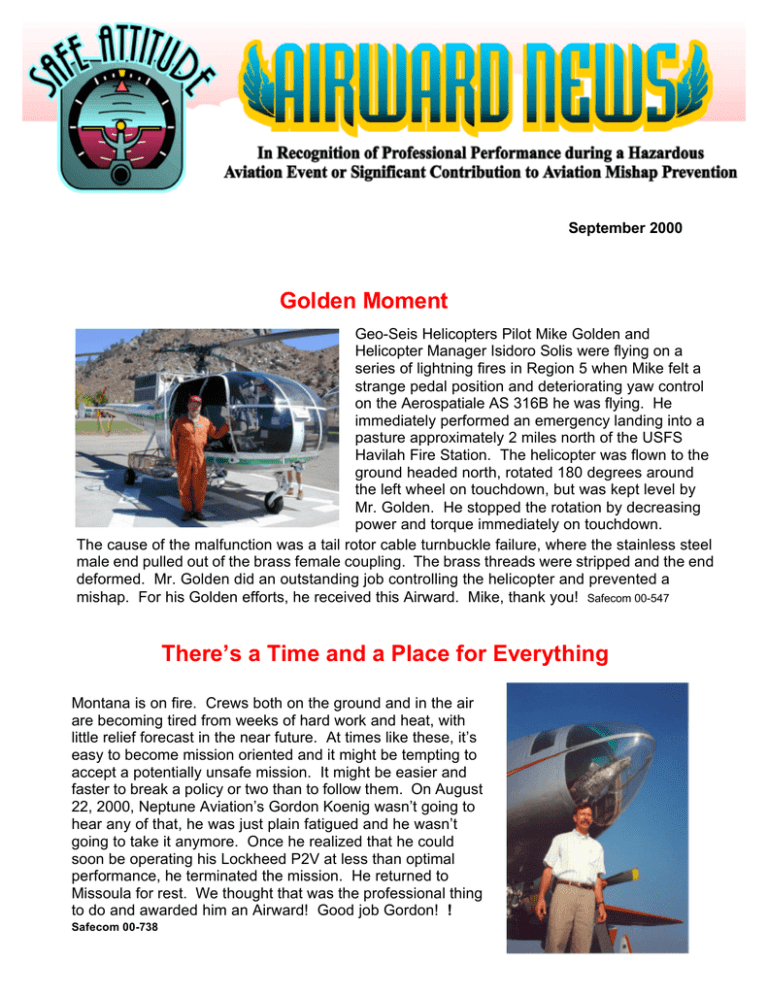
September 2000 Golden Moment Geo-Seis Helicopters Pilot Mike Golden and Helicopter Manager Isidoro Solis were flying on a series of lightning fires in Region 5 when Mike felt a strange pedal position and deteriorating yaw control on the Aerospatiale AS 316B he was flying. He immediately performed an emergency landing into a pasture approximately 2 miles north of the USFS Havilah Fire Station. The helicopter was flown to the ground headed north, rotated 180 degrees around the left wheel on touchdown, but was kept level by Mr. Golden. He stopped the rotation by decreasing power and torque immediately on touchdown. The cause of the malfunction was a tail rotor cable turnbuckle failure, where the stainless steel male end pulled out of the brass female coupling. The brass threads were stripped and the end deformed. Mr. Golden did an outstanding job controlling the helicopter and prevented a mishap. For his Golden efforts, he received this Airward. Mike, thank you! Safecom 00-547 There’s a Time and a Place for Everything Montana is on fire. Crews both on the ground and in the air are becoming tired from weeks of hard work and heat, with little relief forecast in the near future. At times like these, it’s easy to become mission oriented and it might be tempting to accept a potentially unsafe mission. It might be easier and faster to break a policy or two than to follow them. On August 22, 2000, Neptune Aviation’s Gordon Koenig wasn’t going to hear any of that, he was just plain fatigued and he wasn’t going to take it anymore. Once he realized that he could soon be operating his Lockheed P2V at less than optimal performance, he terminated the mission. He returned to Missoula for rest. We thought that was the professional thing to do and awarded him an Airward! Good job Gordon! ! Safecom 00-738 Silver Screen Action, Without the Million Dollar Actors In the style of Hollywood, this event was acted out for real the morning of August 6, 2000. Captain Gene Wahlstrom and Co-pilot Dale Dahl, the crew of a Neptune Aviation Lockheed P2V, had just completed dropping a load of retardant on the High Ore fire and were heading back to Helena, Montana for a load-and-return to the fire when they had a problem with their nose landing gear. They were approaching the airport for a landing when they noticed the nose landing gear would not extend when selected to the down position. Knowing that your nose precedes your face in anything that you do, another attempt to cycle the landing gear commenced, producing the same results. An examination of the nose wheel gear, from the crawlway to the nose compartment, revealed that the ¼” bolt connecting the hydraulic actuator to the up lock mechanism was sheared. In true “McGyver” fashion, they located a bolt and nut of the required dimensions in amongst the spare parts located in the aircraft, and installed them! The gear lowered, and a “normal” landing at the maintenance base in Missoula was executed. They certainly earned their pay that day, and Airwards too. A job well done! SafeCom 00-636 High Three Takes on New Meaning In the Federal Service we refer to the High Three as the pay scale that we draw retirement based upon, but on the afternoon of August 15, 2000, Captain Don Fair and his Co-pilot Wynn Atchison of Conair Aviation found themselves a little short, in an entirely different way. They had just become airborne in their Douglas DC-6 on their way to a fire dispatch, when the Number 2 engine failed. The failure occurred as the landing gear was in transit-up. The Number 2 engine barked hard twice, and then the auto-feather system feathered it. As the aircraft could not maintain altitude on three engines, the retardant load was dropped on the runway at Kalispell, the aircraft climbed away, and engine clean up was carried out. The runway was closed with trucks on it for cleanup of the retardant and the aircraft diverted to Missoula, where Don and Wynn skillfully landed without further incident. Investigation of the fault on the Number 2 engine was actually determined to be an engine nose gear failure. Don and Wynn, thanks for a job well done! SafeCom 00-649 My Name is Brad, I Like to Fly With a Hippie in a tie-dye shirt and sandals painted on the nose of his Lockheed P2V, Neptune Aviation’s pilot Brad Ruble flies the skies above fires (to the tune of over 360 hours flying time for this fire season already) and drops doors and doors of retardant to help the fire fighting efforts on the ground. That’s his story and he’s sticking to it. At least until he feels it necessary to change the story line. Such was the case the evening of August 17, 2000 in Montana. With visibility, lighting and fatigue working against his favor, he cancelled the mission he was asked to do. A hard call to make in one of the busiest fire years in recent memory, but an extremely important and professional one. Thank you Brad. This Airward’s for you! SafeCom 00-739 Kick em’ When Their Up, Kick em’ When Their Down There they were, 200’ above the ground over the Clearwater National Forest with an airspeed of 105-110 knots, when all of a sudden the aircraft pitched down….. In a relatively normal day of dropping people and kicking cargo out the door of their Shorts C-23A, Sherpa, the unexpected occurred. It was a “stable air” evening on July 30, 2000, as Pilot in Command Nels Jenson and Co-pilot Kathy Luken took to the sky to drop off smokejumpers and their cargo. Spotters Wayne Williams and Mitch Kearns had successfully dropped eight smokejumpers and three cargo passes without incident. The fourth pass was a chainsaw box and water cubie. The command to “kick” was given and within a second the aircraft pitched down. The box rose as it exited the aircraft, and traveled over the horizontal stabilizer. Simultaneously the parachute deployed underneath the horizontal stabilizer and the parachute shroud lines became wedged between the fuselage and stabilizer. Backpressure and power were applied. Several other up and down pitches occurred. Both the box breaking away and the chute blowing out caused the aircraft to return to flying in a normal manner. The damage was done and Nels and Kathy knew what they had to do, and they did it with skill, knowledge and Crew Resource Management. They flew the aircraft back to Missoula, declared an emergency, and landed successfully without incident. For their professionalism and crew coordination efforts, not to mention the safe landing, they received Airwards. Thank you Nels and Kathy! No SafeCom submitted Three-peat for Pilot Paul Bradley Although Paul Bradley’s efforts to ensure the safety of his flights could have rewarded him with a possible three Airwards, they were grouped into one Airward. Here’s what he did to deserve it: 1. The Monument Canyon fire on the Sawtooth National Forest was in its second day. The fire was growing rapidly. A Leadplane, a couple of Single Engine Air Tankers (SEATS), and heavy tankers were over the fire. A Call-When-Needed Helicopter manager was with Air Resources Helicopters pilot Paul Bradley, an exclusive use pilot, and his helicopter, a Bell 206L4. The helicopter was not requested to shut down from bucket work when the tankers were in the area since the fire did cover a large area. VHF traffic got very heavy, per usual, when the Leadplane was trying to give the tankers instructions. It was hard to find a break in the communications traffic to speak. Paul saw that this was not a good situation and took it upon himself to return to the helibase and shut down until the traffic could be resolved. 2. The crew was dispatched to Initial Attack (I.A.) the Rankin Fire that was just over the border of the Sawtooth and on the Challis National Forest. Salmon/Challis had hopes that Sawtooth Helitack would be able to handle this fire and had instructed dispatch to run the fire on the Sawtooth Net. It became obvious quickly that this was not a normal I.A. due to fire behavior and other aircraft were dispatched to the fire. Paul recognized quickly that the situation was out of hand due to mixing of fixed wing with rotary wing and landed his helicopter back at the helispot where the Helitack was and they did not take off to clear out of the area until communications were established with all other aircraft in the area. It was quickly recognized that switching back and forth between two forests frequencies was not working. 3. The helicopter was working the West Basin Fire, where it was sent to pick up the Operations Chief and a safety officer for a recon flight of the fire. After briefing and loading the passengers, they departed for the recon. The air to ground and victor were hosting non-stop traffic and after talking to Air Attack several times, no one on board the helicopter, not even the pilot himself, could really say for sure where the other aircraft were working. Paul told the Operations Chief who was on board his helicopter, “I have to return to the pickup point. I cannot ensure the safety of this aircraft or of the people on board it. You are trying to do something here and Air Attack is trying to do something else and the two are not compatible at this point.” The helicopter returned to the helispot and set down until Operations established another mission that could be accomplished. Thanks, Paul, for realizing these three situations that were shouting “WATCH OUT!” and acting upon them! No SafeCom submitted Lead 214 – A New Meaning Gale Wilson gives the term Lead 214 a whole new meaning. Around 0900 on August 26th a Bell 214 heard an unusual sound followed by a master caution light, indicating a loss of tail rotor hydraulic boost. The number 1 hydraulic system was shut down and airspeed was maintained at 80 knots. This is where Gale comes into the picture. Gale was flying his Jet Ranger in the same area, and knowing the area and the situation, he was able to help the 214. Gale knew the 214 would need enough room to make a safe landing and “Lead Copter” he became. He knew of a remote airstrip and led the 214 to it, where the 214 made a safe partial run-on landing with no impact or yaw. Without Gales assistance this could have been a serious accident. Great job Gale, Thanks. SafeCom 00-757 To view SafeComs click here: http://www.aviation.fs.fed.us/safecom/psearch.asp Enter the SafeCom number and click on submit Aviation Safety Office www.aviation.fs.fed.us
